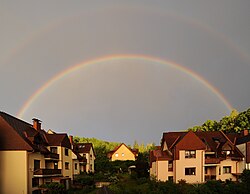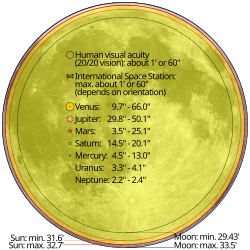ISS over Moon from Houston - JSC2012-E-017827
Größe:
1268 x 1585 Pixel (169242 Bytes)
Beschreibung:
The International Space Station can be seen as a small object in the upper left of this image of the moon in the early evening of 4 January 2012 in the sky over the Houston area, flying at an altitude of 390.8 kilometres (242.8 miles). The space station can be seen in the night sky with the naked eye and a pair of binoculars may reveal some detail of the structural shape of the spacecraft. Station sightings in the area will be possible again (weather permitting) on Friday, 6 January, beginning at 6:11 p.m. CST. Viewing should be possible for approximately six minutes as the station moves from 10 degrees above west-northwest to 10 degrees above south-southeast. The maximum elevation will be 44 degrees. To find sighting details by city, visit:
http://go.usa.gov/81R. Equipment used by the NASA photographer operating from NASA's Johnson Space Center, was as follows: Nikon D3S, 600mm lens and 2x converter, Heavy Duty Bogen Tripod with sandbag and a trigger cable to minimize camera shake. The camera settings were as follows: 1/1600 @ f/8, ISO 2500 on High Continuous Burst.
Weitere Informationen zur Lizenz des Bildes finden Sie hier. Letzte Aktualisierung: Mon, 08 Jul 2024 22:14:59 GMT
Relevante Bilder
Relevante Artikel
Scheinbare Größe
Als scheinbare Größe oder scheinbarer Durchmesser eines Objekts wird in der Astronomie die geometrische Ausdehnung der beobachteten Erscheinung am Himmel bezeichnet. Sie entspricht dem Winkel, unter dem der Umriss eines Gegenstandes den Beobachtenden an ihrem Standpunkt erscheint, dem jeweiligen Gesichtswinkel, auch Sehwinkel genannt. Die Winkelausdehnung hängt von der tatsächlichen Größe des Objekts und dessen Entfernung vom Betrachter ab. Die Abbildung des Gegenstandes auf der Netzhaut im Auge wird außerdem durch brechende Medien wie die Augenlinse bestimmt – beziehungsweise durch zusätzliche optische Systeme vor dem Auge, die den Sehwinkel künstlich vergrößern, wie die eines Feldstechers oder eines Teleskops.
.. weiterlesen






















